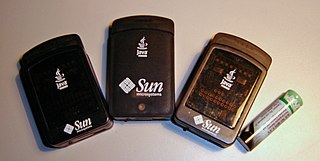IEEE 802.15 is a working group of the Institute of Electrical and Electronics Engineers (IEEE) IEEE 802 standards committee which specifies Wireless Specialty Networks (WSN) standards. The working group was formerly known as Working Group for Wireless Personal Area Networks.

A personal area network (PAN) is a computer network for interconnecting electronic devices within an individual person's workspace. A PAN provides data transmission among devices such as computers, smartphones, tablets and personal digital assistants. PANs can be used for communication among the personal devices themselves, or for connecting to a higher level network and the Internet where one master device takes up the role as gateway.
Zigbee is an IEEE 802.15.4-based specification for a suite of high-level communication protocols used to create personal area networks with small, low-power digital radios, such as for home automation, medical device data collection, and other low-power low-bandwidth needs, designed for small scale projects which need wireless connection. Hence, Zigbee is a low-power, low data rate, and close proximity wireless ad hoc network.
IEEE 802.15.4 is a technical standard which defines the operation of a low-rate wireless personal area network (LR-WPAN). It specifies the physical layer and media access control for LR-WPANs, and is maintained by the IEEE 802.15 working group, which defined the standard in 2003. It is the basis for the Zigbee, ISA100.11a, WirelessHART, MiWi, 6LoWPAN, Thread, Matter and SNAP specifications, each of which further extends the standard by developing the upper layers which are not defined in IEEE 802.15.4. In particular, 6LoWPAN defines a binding for the IPv6 version of the Internet Protocol (IP) over WPANs, and is itself used by upper layers like Thread.

Sun SPOT was a sensor node for a wireless sensor network developed by Sun Microsystems announced in 2007. The device used the IEEE 802.15.4 standard for its networking, and unlike other available sensor nodes, used the Squawk Java virtual machine.
6LoWPAN was a working group of the Internet Engineering Task Force (IETF). It was created with the intention of applying the Internet Protocol (IP) even to the smallest devices, enabling low-power devices with limited processing capabilities to participate in the Internet of Things.
A wide variety of different wireless data technologies exist, some in direct competition with one another, others designed for specific applications. Wireless technologies can be evaluated by a variety of different metrics of which some are described in this entry.

Daintree Networks, Inc. was a building automation company that provided wireless control systems for commercial and industrial buildings. Founded in 2003, Daintree was headquartered in Los Altos, California, with an R&D lab in Melbourne, Australia.

In digital communications, chirp spread spectrum (CSS) is a spread spectrum technique that uses wideband linear frequency modulated chirp pulses to encode information. A chirp is a sinusoidal signal whose frequency increases or decreases over time.
IEEE 802.15.4a was an amendment to IEEE 802.15.4-2006 specifying that additional physical layers (PHYs) be added to the original standard. It has been merged into and is superseded by IEEE 802.15.4-2011.
MiWi is a proprietary wireless protocol supporting peer-to-peer, star network connectivity. It was designed by Microchip Technology. MiWi uses small, low-power digital radios based on the IEEE 802.15.4 standard, and is designed for low-power, cost-constrained networks, such as industrial monitoring and control, home and building automation, remote control, wireless sensors, lighting control, and automated meter reading.
IEEE 1451 is a set of smart transducer interface standards developed by the Institute of Electrical and Electronics Engineers (IEEE) Instrumentation and Measurement Society's Sensor Technology Technical Committee describing a set of open, common, network-independent communication interfaces for connecting transducers to microprocessors, instrumentation systems, and control/field networks. One of the key elements of these standards is the definition of Transducer electronic data sheets (TEDS) for each transducer. The TEDS is a memory device attached to the transducer, which stores transducer identification, calibration, correction data, and manufacturer-related information. The goal of the IEEE 1451 family of standards is to allow the access of transducer data through a common set of interfaces whether the transducers are connected to systems or networks via a wired or wireless means.
Ember was an American company based in Boston, Massachusetts, USA, which is now owned by Silicon Labs. Ember had a radio development centre in Cambridge, England, and distributors worldwide. It developed Zigbee wireless networking technology that enabled companies involved in energy technologies to help make buildings and homes smarter, consume less energy, and operate more efficiently. The low-power wireless technology can be embedded into a wide variety of devices to be part of a self-organizing mesh network. All Ember products conform to IEEE 802.15.4-2003 standards.

Digi XBee is the brand name of a popular family of form factor compatible wireless connectivity modules from Digi International. The first XBee modules were introduced under the MaxStream brand in 2005 and were based on the IEEE 802.15.4-2003 standard designed for point-to-point and star communications. Since the initial introduction, the XBee family has grown and a complete ecosystem of wireless modules, gateways, adapters and software has evolved.

OCARI is a low-rate wireless personal area networks (LR-WPAN) communication protocol that derives from the IEEE 802.15.4 standard. It was developed by the following consortium during the OCARI project that is funded by the French National Research Agency (ANR):

A body area network (BAN), also referred to as a wireless body area network (WBAN) or a body sensor network (BSN) or a medical body area network (MBAN), is a wireless network of wearable computing devices. BAN devices may be embedded inside the body as implants or pills, may be surface-mounted on the body in a fixed position, or may be accompanied devices which humans can carry in different positions, such as in clothes pockets, by hand, or in various bags. While there is a trend toward the miniaturization of devices, in particular body area networks which consist of several miniaturized body sensor units (BSUs) together with a single body central unit (BCU), larger decimeter sized smart devices still play an important role in terms of acting as a data hub or data gateway and providing a user interface to view and manage BAN applications, in-situ. The development of WBAN technology started around 1995 around the idea of using wireless personal area network (WPAN) technologies to implement communications on, near, and around the human body. About six years later, the term "BAN" came to refer to systems where communication is entirely within, on, and in the immediate proximity of a human body. A WBAN system can use WPAN wireless technologies as gateways to reach longer ranges. Through gateway devices, it is possible to connect the wearable devices on the human body to the internet. This way, medical professionals can access patient data online using the internet independent of the patient location.

GreenPeak Technologies was an Utrecht, Netherlands-based fabless company developing semiconductor products and software for the IEEE 802.15.4 and Zigbee wireless market segment. Zigbee technology is used for Smart Home data communications and to facilitate the Internet of Things, the term used to refer to devices designed to be operated and managed by internet-enabled controllers and management systems.
The IEEE 1902.1-2009 standard is a wireless data communication protocol also known as RuBee, operates within the Low Frequency radio wave range of 30–900 kHz. Although very resistant to interference, metal, water and obstacles, it is very limited in range, usually only suitable for short-range networks. The baud rate is limited to 1,200 kB/s, making it a very low-rate communication network as well. This standard is aimed at the conception of wireless network of sensors and actuators in industrial and military environments. One of the major advantage 1902.1 tags is they are extremely low power and last for years on a simple coin size battery and they can be sealed in a MIL STD 810G package. RuBee tags emit virtually no RF and do not produce any Compromising Emanations, as a result are used in high security facilities. RuBee tags are safe and in use near and on high explosive facilities.
Matter is an open-source connectivity standard for smart home and Internet of things devices, which aims to improve their compatibility and security.

The Connectivity Standards Alliance (CSA), formerly the Zigbee Alliance, is a group of companies that maintain and publish the Zigbee and Matter standard, along with several others. The name Zigbee is a registered trademark of this group, and is not a single technical standard. The organization publishes application profiles that allow multiple OEM vendors to create interoperable products. The relationship between IEEE 802.15.4 and Zigbee is similar to that between IEEE 802.11 and the Wi-Fi Alliance.






